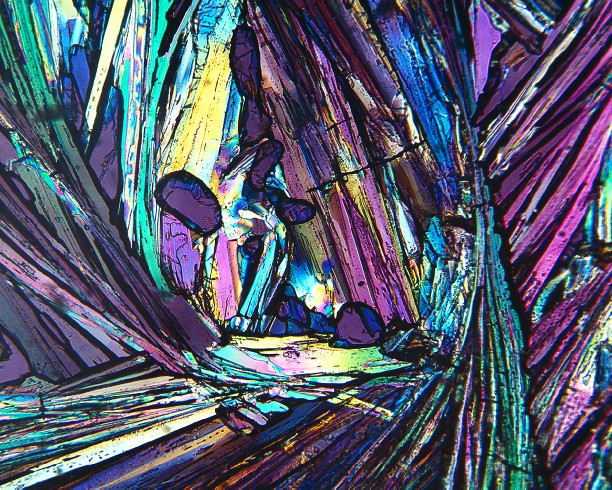Tuesday, January 12, 2016 | By: Jim Zuckerman

This is a picture of ascorbic acid, or vitamin C. I photographed it in a light microscope at 60 times magnification, and in order to get these wild colors I had to use two polarizer filters -- one placed over the light source and one in front of the lens. By rotating one of the filters, the colors emerged. This is called bifringence, and quite a few chemicals have this quality. I took this on film in the 80's with a Mamiya RZ 67 medium format (6 x7cm) camera. The ascorbic acid was heated and melted on a glass microscope slide, and the light source was placed beneath the chemicals.
7 Comments
Feb 23, 2016, 12:26:35 AM
bioimager - The fluorescence microscopy developed to one of the most important tools of the life science area. The observation of the fluorescence emergencies in biological samples delivers differentiates conclusions about morphology and functionality of cells. The objects of examination reach from fixated cells via chromosomes and genes up to observation of processes in living cells.
Due to new techniques and applications, like the fluorescence angiography for examination of ocular fungus, the fluorescence microscopy has blazed a trail into the field of medical diagnostics and therapy. Special importance is set to the possibilities of the intra-operational use.
As highly sensitive and selective tools techniques of fluorescence endoscopy are available in cancer diagnostics. Main topics are here molecular imaging and optical biopsy.
Feb 23, 2016, 12:15:40 AM
Jim - Bioimager, Thanks for your input. I wish I had access to some of this very sophisticated and new technology. I recently contacted a government agency that was doing cryoelectron microscopy of snow flakes to see if I could use their equipment, and they said very decidedly no.
Jan 13, 2016, 11:52:47 AM
Jim - Hi C. There are many, many microscopes you can buy. Olympus has a great line, but other companies do, too. You can also buy used scopes and save a lot of money. Here is one link: http://microscopeinternational.com/olympus-chbs-microscope-4x-10x-40x-hi-100x?gclid=CITt-5atp8oCFdgIgQodvbEDVw
Consider, if you can afford it, getting a trinocular head -- one for the camera and two for the eyes.
Jan 13, 2016, 11:34:33 AM
C Vandenberg - Hi Jim
Want to get into micro (as opposed to macro) photography.
Is it possible to purchase the microscope and, if so, can you provide info (or a link) regarding the brand/model, source, specs?
Thanks
Jan 13, 2016, 7:20:34 AM
Jim - Thanks, Daniel and Carlton. Carlton: With double polarization, you lose about four f/stops. But that is not relevant because nothing is moving and the length of the shutter doesn't matter.
Jan 12, 2016, 11:59:32 PM
Carlton McEachern - Wow - this is so cool - could even be used as a textured background for a composite. What is the f stop hit from using double polarization?
Jan 12, 2016, 10:44:19 PM
Daniel Reynaud - Wow !!! What a shot !! And I had never heard of using 2 polarizers like this before. Impressive result.